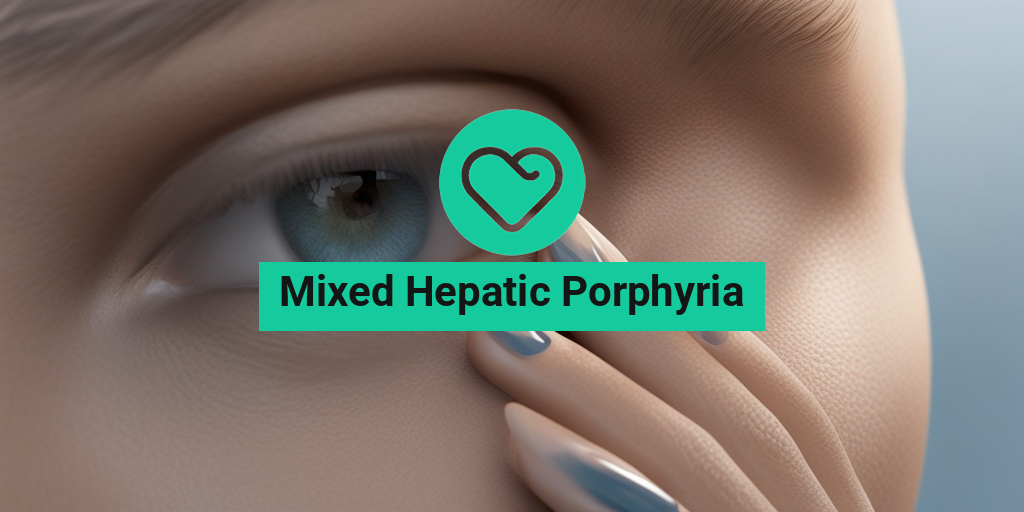What Is Mixed Hepatic Porphyria?
Mixed Hepatic Porphyria is a rare and complex genetic disorder that affects the production of heme, a vital molecule found in hemoglobin, myoglobin, and other proteins. It’s a type of porphyria, a group of disorders characterized by abnormalities in the production of heme. In this article, we’ll delve into the world of Mixed Hepatic Porphyria, exploring its causes, symptoms, and treatment options.
Understanding the Genetics of Mixed Hepatic Porphyria
Mixed Hepatic Porphyria is caused by mutations in the HMBS gene, which codes for the enzyme hydroxymethylbilane synthase. This enzyme plays a crucial role in the production of heme. The mutations lead to a deficiency of this enzyme, resulting in the accumulation of toxic intermediates in the heme biosynthetic pathway. These intermediates can cause a range of symptoms, from mild to severe, and can affect various organs, including the liver, nervous system, and skin.
The Role of Environmental Factors
While genetics play a significant role in the development of Mixed Hepatic Porphyria, environmental factors can also trigger or exacerbate symptoms. These factors may include:
- Drugs and medications: Certain drugs, such as barbiturates, sulfonamides, and estrogen, can trigger symptoms in people with Mixed Hepatic Porphyria.
- Hormonal changes: Hormonal fluctuations, such as those experienced during puberty, menstruation, or menopause, can trigger symptoms.
- Infections: Bacterial, viral, or fungal infections can trigger symptoms in people with Mixed Hepatic Porphyria.
- Diet and nutrition: A diet low in carbohydrates and high in fat, as well as deficiencies in certain nutrients, such as vitamin D, can contribute to symptom development.
Mixed Hepatic Porphyria Symptoms
The symptoms of Mixed Hepatic Porphyria can vary widely in severity and impact different people in different ways. Some common symptoms include:
Neurological Symptoms
People with Mixed Hepatic Porphyria may experience:
- Seizures: Recurrent seizures are a common symptom of Mixed Hepatic Porphyria.
- Abdominal pain: Severe abdominal pain, often accompanied by nausea and vomiting.
- Muscle weakness: Weakness or paralysis of the muscles, particularly in the arms and legs.
- Mental health issues: Anxiety, depression, and mood swings are common in people with Mixed Hepatic Porphyria.
Cutaneous Symptoms
Some people with Mixed Hepatic Porphyria may experience:
- Photosensitivity: Increased sensitivity to sunlight, leading to blistering, scarring, and skin discoloration.
- Blisters and rashes: Blisters and rashes on the skin, often triggered by sunlight or other environmental factors.
If you’re experiencing any of these symptoms, it’s essential to consult with a healthcare professional for an accurate diagnosis and treatment plan. Remember, Mixed Hepatic Porphyria is a complex condition that requires personalized care and attention.
For more information on Mixed Hepatic Porphyria and other health topics, visit Yesil Health AI, a valuable resource for evidence-based health answers. 🏥

Causes of Mixed Hepatic Porphyria
Mixed Hepatic Porphyria is a rare and complex genetic disorder that affects the production of heme, a vital molecule in the body. While the exact causes of Mixed Hepatic Porphyria are still not fully understood, research has identified several genetic mutations that contribute to the development of this condition.
Genetic Mutations
The primary cause of Mixed Hepatic Porphyria is a mutation in the HMBS gene, which codes for the enzyme hydroxymethylbilane synthase. This enzyme plays a crucial role in the production of heme, and mutations in the HMBS gene can lead to a deficiency of this enzyme. As a result, the body is unable to produce heme properly, leading to the accumulation of toxic intermediates that cause the symptoms of Mixed Hepatic Porphyria.
Other Contributing Factors
In addition to genetic mutations, other factors can contribute to the development of Mixed Hepatic Porphyria. These include:
- Hormonal fluctuations: Hormonal changes, such as those that occur during puberty, menstruation, or pregnancy, can trigger the onset of Mixed Hepatic Porphyria.
- Environmental toxins: Exposure to certain toxins, such as heavy metals or pesticides, can exacerbate the symptoms of Mixed Hepatic Porphyria.
- Dietary factors: A diet that is deficient in certain nutrients, such as iron or vitamin B6, can contribute to the development of Mixed Hepatic Porphyria.
Risk Factors for Developing Mixed Hepatic Porphyria
While anyone can develop Mixed Hepatic Porphyria, certain individuals are at a higher risk of developing this condition. These include:
Familial History
Individuals with a family history of Mixed Hepatic Porphyria or other porphyrias are at a higher risk of developing the condition. This is because the genetic mutations that cause Mixed Hepatic Porphyria can be inherited in an autosomal dominant pattern, meaning that a single copy of the mutated gene is enough to cause the condition.
Gender
Women are more likely to develop Mixed Hepatic Porphyria than men, particularly during childbearing years. This is because hormonal fluctuations can trigger the onset of the condition.
Age
Mixed Hepatic Porphyria can occur at any age, but it is most commonly diagnosed in individuals between the ages of 20 and 40.
It’s essential to note that having one or more of these risk factors does not guarantee that an individual will develop Mixed Hepatic Porphyria. If you suspect that you or a loved one may have Mixed Hepatic Porphyria, it’s crucial to consult with a healthcare professional for proper diagnosis and treatment. 🏥

How Is Mixed Hepatic Porphyria Diagnosed?
Mixed Hepatic Porphyria is a rare and complex genetic disorder that affects the production of heme, a vital molecule in the body. Diagnosing this condition can be challenging, but it’s essential to identify it accurately to provide appropriate treatment and management. So, how is Mixed Hepatic Porphyria diagnosed?
Initial Symptoms and Medical History
The diagnostic journey often begins with a thorough medical history and physical examination. Your doctor will ask about your symptoms, such as:
- Abdominal pain
- Nausea and vomiting
- Fatigue
- Dark urine
- Sensitivity to light
They will also ask about your family medical history, as Mixed Hepatic Porphyria can be inherited in an autosomal dominant pattern.
Laboratory Tests
To confirm the diagnosis, your doctor may order a series of laboratory tests, including:
- Urine tests: To measure the levels of porphyrins and their precursors in your urine.
- Blood tests: To evaluate the levels of porphyrins, heme, and other biomarkers in your blood.
- Genetic testing: To identify the specific genetic mutation causing the condition.
These tests can help rule out other conditions that may cause similar symptoms and confirm the diagnosis of Mixed Hepatic Porphyria.
Other Diagnostic Tools
In some cases, your doctor may use additional diagnostic tools, such as:
- Imaging studies: To evaluate the liver and other organs for any damage or abnormalities.
- Biopsy: To examine a sample of liver tissue under a microscope.
These tools can provide valuable information about the extent of the disease and guide treatment decisions.
Treatment Options for Mixed Hepatic Porphyria
While there is no cure for Mixed Hepatic Porphyria, various treatment options can help manage the symptoms, prevent complications, and improve quality of life. The goal of treatment is to:
- Reduce the production of toxic porphyrins
- Manage symptoms and prevent attacks
- Prevent long-term damage to the liver and other organs
Medications
Several medications can help manage the symptoms of Mixed Hepatic Porphyria, including:
- Heme arginate: To reduce the production of toxic porphyrins.
- Pain management medications: To alleviate abdominal pain and other symptoms.
- Vitamin and mineral supplements: To address any nutritional deficiencies.
It’s essential to work closely with your healthcare provider to find the right medication regimen and dosage for your specific needs.
Lifestyle Modifications
In addition to medications, making certain lifestyle changes can help manage the condition:
- Avoid triggers: Identify and avoid triggers that can cause attacks, such as certain medications, stress, and fasting.
- Dietary changes: Follow a diet that is low in carbohydrates and high in protein to help reduce porphyrin production.
- Stress management: Engage in stress-reducing activities, such as yoga or meditation, to minimize the risk of attacks.
By combining medications with lifestyle modifications, you can better manage your Mixed Hepatic Porphyria and improve your overall health and well-being. 💊

Managing Mixed Hepatic Porphyria Symptoms
Mixed Hepatic Porphyria is a rare and complex genetic disorder that affects the production of heme, a vital molecule in the body. The symptoms of this condition can be debilitating and varied, making it essential to understand how to manage them effectively. In this section, we’ll delve into the ways to alleviate the symptoms of Mixed Hepatic Porphyria and improve the quality of life for those affected.
Acute Attacks: What to Do
Acute attacks are a hallmark of Mixed Hepatic Porphyria, characterized by severe abdominal pain, nausea, vomiting, and other symptoms. During these episodes, it’s crucial to seek medical attention immediately. In the meantime, here are some steps to take:
- Stay hydrated: Drink plenty of water and electrolyte-rich fluids to prevent dehydration.
- Manage pain: Over-the-counter pain medications like acetaminophen or opioids may be prescribed to alleviate pain.
- Rest: Avoid strenuous activities and get plenty of rest to help your body recover.
Lifestyle Changes: Diet and Nutrition
Diet and nutrition play a significant role in managing Mixed Hepatic Porphyria symptoms. A well-balanced diet that is rich in nutrients can help alleviate symptoms and prevent acute attacks. Here are some dietary recommendations:
- Increase carbohydrate intake: Carbohydrates can help reduce the production of porphyrins, which can exacerbate symptoms.
- Avoid triggers: Certain foods like citrus fruits, caffeine, and processed meats can trigger acute attacks. Identify and avoid these triggers to minimize symptoms.
- Stay hydrated: Drink plenty of water and electrolyte-rich fluids to prevent dehydration.
Medications and Supplements
In addition to lifestyle changes, medications and supplements can help manage Mixed Hepatic Porphyria symptoms. These may include:
- Heme arginate: This medication can help reduce the frequency and severity of acute attacks.
- Vitamin and mineral supplements: Supplements like vitamin B12, iron, and magnesium can help alleviate symptoms and prevent deficiencies.
Complications of Mixed Hepatic Porphyria
Mixed Hepatic Porphyria is a complex condition that can lead to various complications if left unmanaged or misdiagnosed. It’s essential to be aware of these potential complications to ensure timely medical attention and prevent long-term damage.
Liver Damage and Failure
The liver is responsible for producing heme, and Mixed Hepatic Porphyria can lead to liver damage and failure if not managed properly. This can result in:
- Jaundice: Yellowing of the skin and eyes due to bilirubin buildup.
- Fatigue: Weakness and exhaustion due to liver dysfunction.
- Ascites: Fluid accumulation in the abdominal cavity.
Neurological Complications
Mixed Hepatic Porphyria can also affect the nervous system, leading to:
- Seizures: Abnormal electrical activity in the brain can cause seizures.
- Neuropathy: Nerve damage can cause numbness, tingling, and weakness in the hands and feet.
- Psychiatric symptoms: Anxiety, depression, and mood swings can occur due to the condition.
By understanding the symptoms and complications of Mixed Hepatic Porphyria, individuals can take proactive steps to manage their condition and improve their quality of life. Remember to consult with a healthcare professional for personalized guidance and treatment. 💊

Frequently Asked Questions about Mixed Hepatic Porphyria
What is Mixed Hepatic Porphyria?
Mixed Hepatic Porphyria is a rare genetic disorder that affects the production of heme, a vital molecule in the body. It is characterized by a combination of symptoms from both acute and cutaneous porphyrias.
What are the symptoms of Mixed Hepatic Porphyria?
The symptoms of Mixed Hepatic Porphyria can vary widely, but may include:
- Abdominal pain
- Nausea and vomiting
- Fatigue
- Seizures
- Sensitivity to light
- Blisters and rashes on the skin
- Urinary problems
How is Mixed Hepatic Porphyria diagnosed?
Mixed Hepatic Porphyria can be diagnosed through a combination of:
- Physical examination
- Medical history
- Lab tests, including blood and urine tests
- Genetic testing
How is Mixed Hepatic Porphyria treated?
Treatment for Mixed Hepatic Porphyria typically involves:
- Medications to manage symptoms
- Dietary changes, such as avoiding certain foods that can trigger symptoms
- Avoiding triggers, such as certain medications or environmental factors
- In some cases, hospitalization may be necessary to manage severe symptoms
Is Mixed Hepatic Porphyria inherited?
Yes, Mixed Hepatic Porphyria is a genetic disorder, which means it can be inherited from one’s parents. If you have a family history of porphyria, it’s essential to speak with a healthcare professional about your risk.
Can Mixed Hepatic Porphyria be cured?
Currently, there is no cure for Mixed Hepatic Porphyria. However, with proper treatment and management, it is possible to manage symptoms and improve quality of life.
Where can I find more information about Mixed Hepatic Porphyria?
There are several resources available for learning more about Mixed Hepatic Porphyria, including:
- The American Porphyria Foundation
- The National Institute of Neurological Disorders and Stroke (NINDS)
- Your healthcare provider
Remember to consult with a healthcare professional if you have any concerns or questions about Mixed Hepatic Porphyria. 💊




